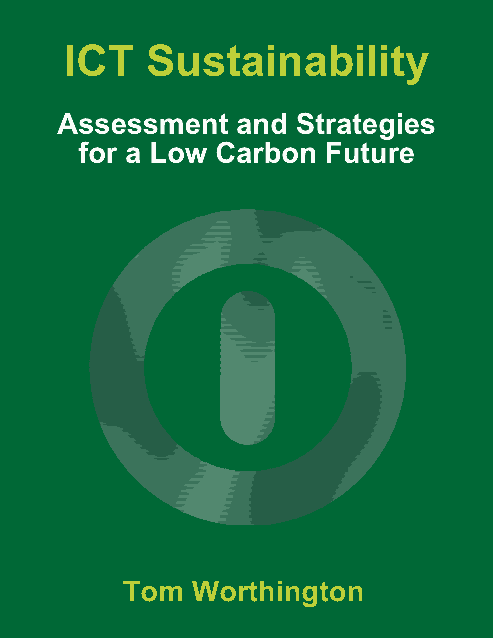From the book: Green Technology Strategies
Energy saving - Data Centres and Client Equipment
Computers and telecommunications equipment contributes about 2% to greenhouse gas emissions. Data centres and client equipment can be made more efficient.
Client Equipment
Client equipment (desktop computers and printers) consume more energy and materials than data centres. The Natural Edge Project (TNEP) suggest four steps for minimising energy and materials consumption:
Assess energy consumption by monitoring client equipment
Consolidate operating client equipment only when necessary and removing unnecessary equipment
- Innovate by:
Right-sized client equipment: do not buy more, or more powerful, equipment than needed
Power management strategies: Turn off client equipment when not needed and turn on power management options in the equipment.
Low-energy equipment: Select low energy component and equipment, such as processors, monitors, power supplies, RAM, flash memory and hard disks.
Eco-Labels: Look for equipment meeting low energy standards.
Manage and monitor the equipment and schedule high energy activities out of peak periods.
Data Centres
Data centers are centralised facilities built to house computer systems, telecommunications and data storage equipment. These may be equipped with power conditioning equipment, backup power supplies (uninterruptible power supplies: UPS) and air conditioning.
A shortage of data centre space and need for increased computer systems has resulted in increasing density of Data Centres equipment and consumption of large amounts of energy, both by the ICT equipment and the air conditioning needed to cool it.
The Natural Edge Project (TNEP) suggest seven steps for minimising energy and materials consumption:
Determine the required services for the client environment.
Consolidate and virtualise servers, turning off unused equipment and reducing the amount of server hardware required.
Invest in low-energy IT equipment with power management technologies, low processors, efficient power supplies and low power storage.
Optimise the layout of the data centre equipment to reduce the cooling load.
Optimise airflow around equipment by orienting and spacing equipment to reduce hotspots.
Invest in low-energy cooling technologies, such as direct liquid cooling.
Practise energy conscious management by allocating accountability for energy consumption and costs, and providing reports.
Consider this as preparation for your assignment two.
Reading
Read now:
- Client Equipment(Lecture 3) and Data Centres (Lecture 4) from The Engineering Sustainable Solutions Program, Sustainable IT Lecture Series, Natural Edge Project, 2008. Note: it is not necessary to undertake the "Required Reading" listed in the Natural Edge notes.
- Browser Power Consumption, By Robert Hansen, SecTheory LLC, 12/01/2008
- Setting up a data centre in regional Australia (Video), Mach Technology, 2008.
Questions:
- Categorise the major uses of energy in your organisation: Categorise the major uses of energy in your organisation you identified last week into types of Client and Data Centre equipment. Include references to your sources of information (with links to any web based information).
- Minimising energy and materials consumption for client equipment: Explain in up to three paragraphs any recent examples of steps for minimising energy and materials consumption for client equipment by Assessment, Consolidation, Innovation, or Management, or other techniques.
- Minimising energy and materials consumption for data centres: Explain in up to three paragraphs any recent examples of steps for minimising energy and materials consumption for data centres by determining required services, consolidation, virtualisation, low-energy equipment, layout and airflow optimisation, low-energy cooling or energy conscious management.
From the book: Green Technology Strategies
This book is about how to reduce carbon emissions and achieve other environmental benefits by using computers and telecommunications technology. It is designed to be used within an online course for professionals, using mentored and collaborative learning techniques.
Title: Green Technology Strategies: Using computers and telecommunications to reduce carbon emissions
Copyright © Tom Worthington, 2009
Publisher: Tomw Communications, PO Box 13, Belconnen ACT 2617, Australia. Website: http://www.tomw.net.au/green
- ISBN: 978-0-9806201-7-7 (Website October 2009)
- ISBN: 978-0-9806201-4-6 (Hardcover January 2010)
- ISBN: 978-0-9806201-3-9 (Paperback October 2009)
- ISBN: 978-0-9806201-2-2 (PDF e-Book October 2009)
- ISBN: 978-0-9806201-6-0 (Amazon Kindle e-Book January 2010)
- ISBN: 978-0-9806201-5-3 (Large-print Paperback January 2010)
- IMS Content Package (May 2011)
- Moodle Backup File (May 2011)
- Apple iPad and other ePub readers (June 2011)
New edition available: ICT Sustainability: Assessment and Strategies for a Low Carbon Future, September 2011.
These notes are used for the courses:
Green ICT Strategies (ACS25): offered in the Postgraduate Program of Open Universities Australia and available from 2010 to students of Curtin University, Griffith University, Macquarie University, Monash University, RMIT University, Swinburne University and the University of South Australia,
Green Technology Strategies: offered in the Computer Professional Education Program, Australian Computer Society (first run as "Green ICT Strategies" in February 2009), and
Green Information Technology Strategies (COMP7310), in the Graduate Studies Select program, Australian National University (first run July 2009).
The notes were first published as an electronic and paperback book in 2009 (Green ICT, Tom Worthington, Tomw Communications, 2009). Students can download or print their own copy of the e-book from the course learning management system, which is likely to be more up to date.
Green Technology Strategies: Using computers and telecommunications to reduce carbon emissions by Tom Worthington is licensed under a Creative Commons Attribution-Share Alike 2.5 Australia License, except for institutions covered by a Copyright Agency Ltd Statutory Licence.
